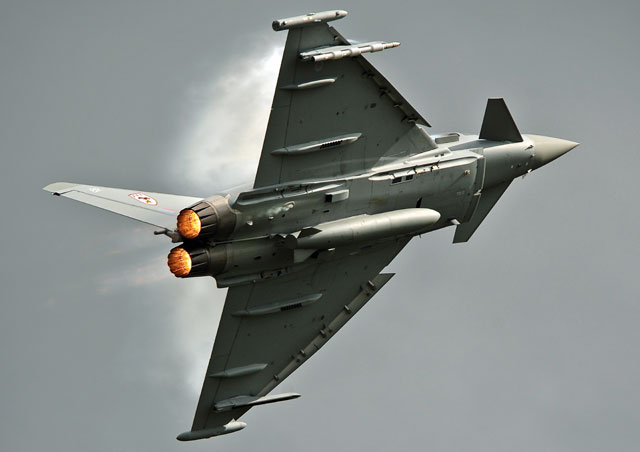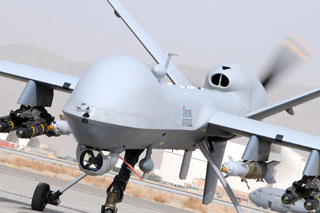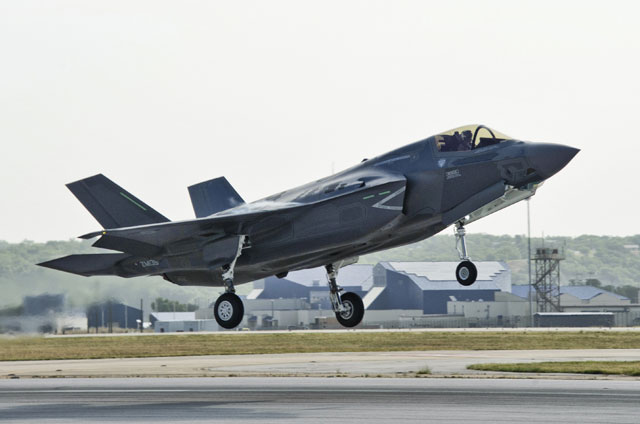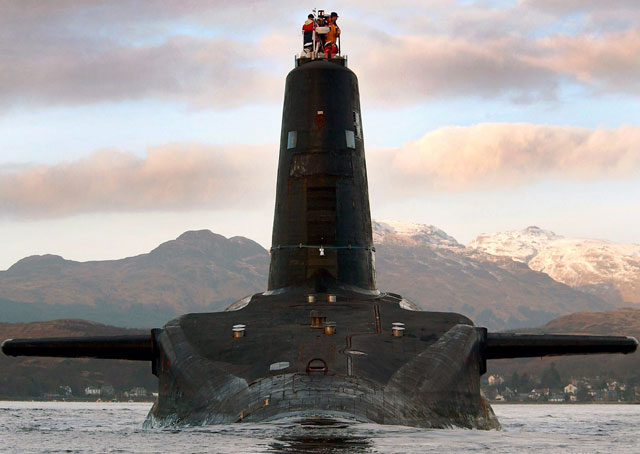At first glance, the confirmation of a UK Ministry of Defence plan to spend £159 billion ($240 billion) on equipment and support by 2022 is an encouraging sign for the nation's armed forces, especially during a time of financial belt-tightening.
Left unchanged since it was revealed by defence secretary Philip Hammond in May 2012, the 10-year allocation includes a 1% increase in real terms per annum after 2014-2015. This will see spending rise from £13.2 billion in the 2012-2013 financial year to more than £18.8 billion at the end of the cycle.
 |
|---|
| Crown Copyright Expanding the Typhoon's multirole potential is a priority for the use of unallocated funds |
An ongoing restructuring of the UK military will, in time, lead to the air force, army and navy coming under a so-called Future Force 2020 structure, which was outlined in the current coalition government's Strategic Defence and Security Review (SDSR) of September 2010. This process has already resulted in deep cuts to personnel and equipment levels as part of an effort to eradicate what Hammond describes as past "poor project management, weak decision-making and financial indiscipline". Such factors had contributed to a gap of about £74 billion between the MoD's procurement commitments and ability to pay, according to a review by the UK National Audit Office (NAO).
The MoD's 31 January publication of the Defence Equipment Plan 2012 confirms Hammond has now balanced the books, with the budget for the first time also containing a financial risk and contingency provision of £13.2 billion to cover unexpected cost over-runs and £8 billion in unallocated funding to be used against emerging needs.
"All three services now have greater input and more certainty than ever before about what equipment they will have and when," says chief of the defence staff Gen Sir David Richards. "The clarity provided by the equipment plan shows that Future Force 2020 is affordable and achievable."
But while the document has brought some fresh clarity to the military and its suppliers in terms of the MoD's procurement commitments, a deeper assessment of its only 20 pages of text and funding graphs leaves key questions unanswered. In truth, the armed services will each be faced with making more difficult decisions during the next several years, most immediately as they scale down their more than decade-long combat involvement in Afghanistan.
According to the MoD's plan, combined procurement activities will account for about £60 billion, or roughly 38% of its £159 billion spending until 2021-2022. The bill for supporting its in-service and newly acquired equipment will account for £86 billion, or 54%, it says.
SERVICE ALLOCATIONS
With the UK's land forces having received major investment during the past several years because of their action in the fight against the Taliban in Afghanistan, the Royal Air Force and Royal Navy will each now receive substantially more than the British Army.
 |
|---|
| Crown Copyright Reaper UAVs must attract core funding if operations are to continue after 2015 |
The RN's total 33% share of the money will allow both of its Queen Elizabeth-class aircraft carriers to be completed, along with other new surface ships for £17.4 billion. The Astute-class attack submarine programme, early work leading to the replacement of its Trident-armed Vanguard-class ballistic missile boats, and other activities to maintain the UK's independent nuclear deterrent capability will account for £35.8 billion; little more than 22% of the spending total.
By contrast, spending on armoured fighting vehicles and other land equipment for the army will total £12.3 billion, or about 7.7% of the procurement and support allocation.
"The RAF are the past masters of political massage, and the Royal Navy have shown a surprising turn of speed in this area of late," says Francis Tusa, editor of UK publication Defence Analysis. "The result is that both will leave the army in their wake, especially as it is pushed out of the limelight as the Afghan mission draws to an early end."
Rotorcraft projects, including upping the RAF's Boeing CH-47 Chinook fleet to 60 aircraft, will cost £12.1 billion, and programmes to buy missiles, torpedoes and precision-guided bombs are to value about £11.4 billion.
UNCOMMITTED FUNDS
With several major new acquisitions to be considered as part of the next SDSR process during 2015, parts of each equipment area include planned, but as-yet uncommitted, segments of core budget.
For the air domain, this includes planned new spending on the Eurofighter Typhoon. "Further investment to develop and enhance the aircraft's multirole and intelligence, surveillance, target acquisition and reconnaissance capabilities are priorities for use of unallocated headroom in the plan budget," the MoD says. Another priority when funds allow "will be to expand our investment in simulated pilot training", it adds.
The RAF is due to retire its last Panavia Tornado GR4s in 2019, and the Eurofighter is not yet cleared to use either the MBDA Brimstone air-to-surface missile or Raytheon Systems Paveway IV precision-guided bomb - the service's weapons of choice in Afghanistan and Libya - or MBDA's Storm Shadow cruise missile, used in Iraq and Libya.
Funding has yet to be guaranteed to produce a new Captor-E active electronically scanned array radar for Typhoon partners Germany, Italy, Spain and the UK, or to fully integrate MBDA's Meteor beyond visual-range air-to-air missile. Money for such work will have to be made available later this decade as spending on the F-35 also begins to ramp up with increased production.
It is uncertain whether the UK will proceed with its previously planned final Tranche 3B purchase of Eurofighters for the RAF. In January, the service received its 100th Typhoon, against an original 232-aircraft commitment, later revised to 208.
 |
|---|
| Lockheed Martin A planned 48 STOVL F-35Bs should be acquired during the 10-year spending period |
In May 2012, the UK reverted its procurement plans to buying the short take-off and vertical landing F-35B, following a brief but expensive dalliance with the carrier variant C model. A last-minute attempt to switch was abandoned when the massive costs linked to converting at least one of the RN's aircraft carriers became apparent, but only after the planned shift had wasted £100 million.
"Our commitment over the first 10 years is for 48 [F-35Bs]," the MoD's permanent secretary Jon Thompson told the House of Commons defence committee in late 2012. "Over time, we would expect the number to rise to beyond three figures, but that would be in the second decade," he added. The MoD is expected to order its first operational example during the course of 2013, but exact numbers should become clearer via the next SDSR.
The MoD says decisions on how to spend the £8 billion of "headroom funding" which has yet to be allocated will be taken by the Armed Forces Committee.
"This will allow us to fund, incrementally and flexibly, a number of additional programmes that are a high priority for defence, as soon as we can be sure that they are affordable," Hammond says. "We will do so only at the point when commitment is required to meet the operational requirement and only in accordance with the military assessment of priority at the time."
But the UK's equipment profile faces a major challenge as it moves towards withdrawing its last combat forces from Afghanistan before the end of 2014. The MoD must decide which of the equipment acquired under the urgent operational requirement (UOR) model will be retained within its core budget. Many systems, including the RAF's General Atomics Aeronautical Systems Reaper remotely piloted air systems and Raytheon-modified Hawker Beechcraft King Air 350ER-based Shadow R1 surveillance aircraft, have been acquired and supported under UOR deals using money from the Treasury reserve fund, and not the MoD equipment budget.
The MoD estimates the net additional cost of operations in Afghanistan as having totalled £17 billion between 2001 and March 2012, including about £3.8 billion each in the financial years starting in 2009 and 2010.
Decisions on what to bring back - and fund - as part of the core defence fleet have yet to be taken, with the MoD repeatedly having stated it has yet to determine what will happen to its armed Reapers post-2015. This is despite an expected programme spend of more than £500 million since the type was introduced in 2007, and an ongoing fleet expansion which will take the number of air vehicles available to the RAF's 13 and 39 squadrons to 10. A UK ground control station for the type has also been established at its Waddington base in Lincolnshire, with 31 service personnel qualified to pilot the type and 16 more to follow by September 2013.
URGENT ATTENTION
Primarily used to deliver intelligence, surveillance, target acquisition and reconnaissance services, the UK's Reapers are flown from Kandahar airfield. The MoD says its aircraft had released 52 Raytheon Paveway II-series 226kg (500lb) laser-guided bombs and 293 Lockheed Martin AGM-114 Hellfire air-to-surface missiles by 22 October 2012.
Elsewhere, the UK's current Defence Equipment and Support (DE&S) organisation also faces a major structural overhaul from later this decade, with a private sector-operated successor being considered by the MoD. In 2012, private-sector company Serco was selected to assist with a review process.
In its Defence Acquisition report of 5 February, the cross-party House of Commons defence committee says it "agrees with the government that the current arrangements for acquisition, constrained by public sector employment rules, are unsatisfactory. But the proposal to entrust acquisition to a government-owned, contractor-operated company is not universally accepted as the best way forward, and there are particular concerns about how the MoD's overall responsibility for acquisition could be maintained."
 |
|---|
| Crown Copyright Updating the Royal Navy's ballistic missile submarine force and also retaining the UK's independent nuclear deterrent will account for 22% of the total defence equipment plan |
Support and maintenance costs are substantial, with contracts linked to the RAF's Tornado and Typhoon fleets having valued more than a combined £880 million during the 2011-2012 financial year, the MoD says. Reforming DE&S to deliver greater efficiency and cost savings remains a key priority.
Meanwhile, a separate factor which could affect the cost and schedule performance of the UK's defence acquisition projects concerns the MoD's new and more stringent requirements for the certification and release to service of new aircraft and systems. Established following the recommendations of the Haddon-Cave review, which investigated the loss of Nimrod MR2 XV230 over Afghanistan in 2006, the UK Military Aviation Authority is driving through tougher controls over the safety standards acceptable for incoming and operational equipment.
The MoD's desire to bring the British Army's Watchkeeper unmanned air system into use with civilian certification continues to delay the type's planned introduction to use in Afghanistan, despite this objective having originally been scheduled during 2010. A new announcement on when the asset will be fielded is expected later in 2013.
A senior RAF official also warned late last year that while the service's acquisition of three RC-135 Airseekers from the USA remains on budget and on time to enter operational use in October 2014, difficulties could be encountered during certification of the Boeing 707-based system.
Despite such challenges, the NAO says the MoD's equipment planning is now being performed "on a more prudent basis", although it suggests the department's attitude to risk "is still over-optimistic", when judged against its past performance in buying new equipment. However, Hammond notes: "The [NAO] assessment of the equipment plan will take place annually so that parliament will gain ever greater levels of confidence that the MoD equipment plan is affordable and will fulfil our capability requirements."
Only time will tell if the UK has truly brought the desired level of military precision and adaptability to its buying practices to meet the challenges of the future.
Source: Flight International























